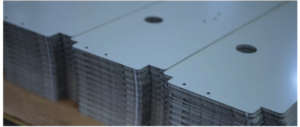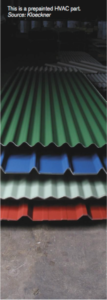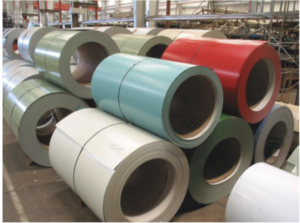

By Aaron Small, Feb. 2018
Between pre-paint and PVD, there are endless combinations for products that have unique topographical, colored, or functional variations.
PVD Like Never Before
The PVD process is common in the medical, industrial, commercial and jewelry markets. Once limited due to the sizes of early cabinets or vessels, PVD has grown from small parts and pieces into much larger components and sheets. The PVD process has long been described as a batch type and the advancements of both the type of PVD equipment technologies and the increasing number of machines and size of machines have opened numerous doors.
PVD occurs when a selected inert metallic disc is vaporized and combined with a selected inert gas in a controlled heated environment. The PVD process applies a consisting coating onto the base metal underneath. Since the PVD process involves vaporizing a metal and applying it to a resilient base surface, i.e. stainless steel, it allows designers to elevate the value of stainless steel with both a functional touch surface and a specialized metallic surface appearance of rose gold, platinum, or emerald.
Interestingly, where pre-paint will affect a different topography appearance by either changing the coating formulation or by mechanically manipulating the total product after it is painted, the PVD appearance is altered by changing the metal surface before it goes into the PVD process.
This allows the metal surface to be brushed, polished, or mechanically affected in another pattern before it gets the color coat and gives designers the opportunity to coat a wide range of metal thicknesses. At a new level of realism, architects, designers, and specifiers can put together entire projects with high-end metallics, and do so while employing an environmentally positive process.
Pre-Paint Expands
Pre-paint started off with the acrylic and polyester coating of narrow aluminum coils and was initially sold to the aluminum awning industry. It is now a major player in a slew of industries: building products, interior and exterior architectural design, HVAC, appliance, automotive, office furniture, and other functional and aesthetic markets. Continuous coil coating is a high-speed process that can apply paint or laminate onto several types of metal or aluminum in staggering quantities in a short amount of time.
Nowadays, many new surface textures and topographies are showing up in virtually every market. Pre-paint, or laminated surfaces, can be formulated in order to reach a wide range of pigmented colors, designs, textures, and emboss patterns. As well, there have been advances in lower maintenance surfaces that can include one or more of the following properties: anti-fingerprint, anti-microbial, and anti-graffiti. Plus, the industry can now coat widths of up to 72” alongside a wide range of thicknesses of flat rolled sheet in coil form. Once you know the collective demands of a project, a seasoned coil coating professional can guide the project in the right direction—and the options now feel limitless.
PVD & Pre-Paint: A Good Match
Pre-paint and PVD in most cases have a distinct aesthetic, but they’re now commonly found on the same structures around the world, such as a high-end commercial complex or a professional or collegiate athletic stadium. The use of both is increasingly visible on projects where the customer has or is developing a strong logo presence. Architects and designers are finding that the ability to use both products as complementary is like having an extra arrow in their quiver.
That trend is just now starting to be spot- ted in appliance design shows and exhibits around the world and garnering interest from all types of manufacturers and designers. Already, PVD and pre-paint have been showcased in high-end appliances thanks to trials, prototypes, and products that are increasingly available in qualities appropriate to the appliance manufacturing sector. Both PVD and pre-painted products have been recognized in award-winning architectural designs, each thanks to their own attributes that have set the benchmark for great design.
Challenges
Between pre-paint and PVD, there are endless combinations for products that have unique topographical, colored, or function- al variations. Designers and architects have a whole new world of possibilities open to them. However, challenges persist. Because PVD is still a batch process, small quantities of job-specific needs can be easier to come by depending on the size. Pre-paint, which is generally a high-speed application that requires a minimum amount of lineal foot- age in coil form, makes itself more suited for larger quantities.
For architects, designers, and specifiers looking for two or three panels or parts to dress up their design, PVD is a natural fit. Meanwhile, pre-paint is better suited for larger jobs, especially when the overall need is not an established total product. However, don’t discount one or the other until all of the needs have been identified and the experts who are familiar with both have been heard. Otherwise, projects risk major lost opportunities in design and functionality.
Next Steps
For any designer, specifier, or architect looking to expand their use of pre-paint or PVD, there are four essential questions to ask:
The answers to these questions will guide your next step in deciding if PVD or pre- paint is right for all or individual parts of each project. Capabilities have expanded and aesthetics have blurred, but strengths prevail and, for some applications or aesthetic desires, one might still be better suited than the other. Making functional and design decisions will be made easier by asking these questions and employing someone without an agenda who has experience with both. Other points of parity include budget, ecology, topographical (i.e. anti-microbial, anti-fingerprint), and colors.
In all, there are a lot of great choices to consider with products that have been around for a long time, but are showing new and exciting possibilities. The key is starting off with the knowledge of what is available and how the variables might affect your project. Now you can talk to experts who have knowledge of both products and can supply you with your choice, whichever that might be. It is an exciting time to work in appliance design.



Aaron Small, corporate director of coil coated services, Kloeckner Metals Corp. Learn more at kloecknermetals.com and on Facebook, LinkedIn, Twitter and YouTube.
Article can be found: http://digital.bnpmedia.com/publication/?i=470617&ver=html5&p=18#{“page”:”18″,”issue_id”:470617}

Steel base plates are fundamental elements employed in various manufacturing...
Metal fabrication is a critical process that transforms raw metal...
The solar industry has undergone a significant transformation by incorporating...

X
The Kloeckner Metals website uses modern technologies. Unfortunately, your browser doesn't support those technologies.
Download the latest version of one of these browsers to experience the site: